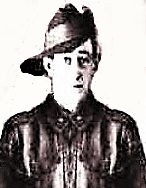
7689
POLLITT, Alexander Gerald
| Service Numbers: | 1117, 7584 |
|---|---|
| Enlisted: | Not yet discovered |
| Last Rank: | Private |
| Last Unit: | 10th Infantry Battalion |
| Born: | Port Pirie, South Australia, 28 March 1894 |
| Home Town: | Port Pirie, Port Pirie City and Dists, South Australia |
| Schooling: | Not yet discovered |
| Occupation: | Labourer |
| Died: | Natural Causes, Largs North, South Australia, 22 March 1970, aged 75 years |
| Cemetery: |
Centennial Park Cemetery, South Australia |
| Memorials: |
World War 1 Service
| 22 Dec 1914: | Involvement AIF WW1, Private, 1117, 12th Infantry Battalion, --- :embarkation_roll: roll_number: '10' embarkation_place: Melbourne embarkation_ship: HMAT Themistocles embarkation_ship_number: A32 public_note: '' | |
|---|---|---|
| 22 Dec 1914: | Embarked AIF WW1, Private, 1117, 12th Infantry Battalion, HMAT Themistocles, Melbourne | |
| 14 May 1915: | Wounded AIF WW1, Private, 1117, 12th Infantry Battalion, ANZAC / Gallipoli, GSW Right leg | |
| 29 Feb 1916: | Discharged AIF WW1, 1117, 12th Infantry Battalion | |
| 30 Oct 1917: | Embarked AIF WW1, Private, 7584, 10th Infantry Battalion, HMAT Aeneas, Melbourne | |
| 30 Oct 1917: | Involvement AIF WW1, Private, 7584, 10th Infantry Battalion, --- :embarkation_roll: roll_number: '10' embarkation_place: Melbourne embarkation_ship: HMAT Aeneas embarkation_ship_number: A60 public_note: '' | |
| 24 Apr 1918: | Wounded | |
| 11 Nov 1918: | Involvement AIF WW1, Private, 7584, 10th Infantry Battalion |
Help us honour Alexander Gerald Pollitt's service by contributing information, stories, and images so that they can be preserved for future generations.
Add my storyBiography contributed by St Ignatius' College
Alexander Gerald (Gerry) Pollitt was born in Port Pirie, South Australia on the 8th of March 1894. He enlisted twice in the AIF: the first time on 16 September 1914, the second on 6 October 1917. Pollitt was wounded on Gallipoli and so returned to Australia and discharged. But he rejoined, despite knowing what he would be returning to, and was sent to France.
After they had completed basic training in Australia in late 1914, Pollitt and the rest of the soldiers in the 10th battalion travelled to Egypt to complete more advanced training. Once they had finished their training, the 10th battalion was committed to the Gallipoli Campaign. Pollitt embarked from Melbourne, Victoria aboard the HMAT A60 Aeneas. Pollitt and his battalion were part of the landing at ANZAC Cove in Gallipoli on the 25th of April 1915. The 10th battalion was among the first groups to come ashore as they worked as the covering force. Soldiers from the 10th Battalion got the furthest inland out of all ANZAC troops. On the 15th of May 1915, Pollitt suffered a ‘general service wound’ to his right leg whilst fighting in Gallipoli. Because of his injury, Pollitt was taken to Alexandria Hospital in Egypt. He was badly wounded and had to return to Australia.
At the time of his second enlistment, he was a labourer and his marital status was single. His religion was Church of England. He was part of the 10th Battalion, 25th reinforcement. He was 6’ 5” which was extremely tall at that time and had brown hair and brown eyes. At enlistment, he listed his sister Ms. I M Perkins as his next of kin. She was going to be the first to find out should something have happened to Pollitt. He was ranked as a private at enlistment. He survived the whole war and returned to Australia on the 13th of February 1919 aboard the SS Karoola.
ABC 2011, Understanding the ANZAC spirit, accessed 26 March 2019, <https://www.abc.net.au/news/2011-04-25/larkin---understanding-the-anzac-spirit/166658>.
AIF Project 2016, accessed 5 March 2019, <https://www.aif.adfa.edu.au/showPerson?pid=243035>.
Australian War Memorial n.d, accessed 5 March 2019, <https://www.awm.gov.au/advanced-search/people>.
National Archives of Australia 2019, accessed 5 March 2019, <https://recordsearch.naa.gov.au/SearchNRetrieve/Interface/SearchScreens/BasicSearch.aspx>.
Wikipedia n.d., 10th Battalion (Australia), accessed 26 March 2019, <https://en.wikipedia.org/wiki/10th_Battalion_(Australia)>.
The ANZAC spirit is a concept that suggests that the Australian and New Zealand troops had the same characteristics and qualities that they showed on the battlefield in World War I. The qualities that are associated with ANZAC spirit are endurance, courage, ingenuity, good humour, larrikinism, and mateship. The ANZACS were widely respected by other nations on both sides of the war for showing these qualities. The ANZACS even earned the nickname “diggers” because of their compromise during the Gallipoli campaign where they had no choice but to dig trenches even though they had landed in the wrong place and were inexperienced. Alexander Gerald Pollitt showed great ANZAC spirit, especially with courage. He enlisted into war even though he had no experience and didn’t necessarily know what he was getting himself into. Just like so many young Australians who enlisted themselves into the Australian Imperial Force, he was prepared to fight and even die for his country.
















